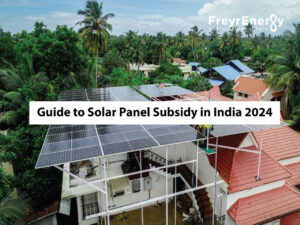Solar power is a resourceful alternative source of energy that has made a drastic entrance into the Indian ecosystem and society. The last few years have seen a significant shift in preferences and have seen crores of Indians showing interest in adopting the shift in solar consumption. The movement has allowed technology to grow and adapt with some of the best photovoltaic panels at the time.
Back in the day, there were no subsidies or offers that made the cost of installing solar panels affordable. In short, it was an expensive investment for individuals and businesses to install such panels and wait for ROI to reflect. Today, thanks to subsidies like PM Surya Ghar Muft Bijli Yojana has changed the game and has allowed consumers to get hold of the system and solar PV panel cost for a reduced amount With that being said, let’s explore more about the types of panels, the cost of installation and the overall ROI one would benefit in the times to come.

Solar Panels: All about It
There are three most commonly available solar panels, which include:
- Monocrystalline: Monocrystalline is one of the best photovoltaic panels available in India today. These panels have an efficiency rating between 16-24%, which is ideally suited for residential uses. They have a significantly higher lifespan of nearly 25 years alongside AMC warranties and have minimal maintenance. Mono-perc is a variant of Monocrystalline solar panel that offers an extra layer of PERC technology, which makes it even more efficient while absorbing solar energy.
- Polycrystalline: A Polycrystalline panel is another efficient type of PV panels that is made by melting numerous clusters of silicon crystals together. In addition to their structure, they have the same lifespan of 25 years and have a significantly lower price than monocrystalline. However, in terms of efficiency, they are second in line behind monocrystalline with 13-16% efficiency ratings.
- TOPCon Panels: TOPCon is arguably the newest of the lot that uses a passivated oxide layer over the PV panels to deliver a super-efficient solar panel. Over time, TOPCon panels have become the number one choice amongst consumers and installers for its top notch performance and positive value for money. As per observation, these panels offer a whopping 28% efficiency that’s unheard of. However, this comes at the highest price tag of the lot, but in turn, ensures a fast ROI.
Cost of Installation
Let’s break down solar PV panel cost breakdown one by one:
- Cost of Panels: Firstly, it depends on the type of panels you might opt for. A TOPCon type could cost the highest, while Monocrystalline and Polycrystalline are lower. In this case, the range varies between INR 35,000 and INR 50,000 for a 1kW panel.
- Inverters: Inverters are crucial and play an important role. The most basic ones start from INR 20,000, which is the 1 kW On-grid inverter, and the price goes close to INR 1 lakh for a model of 10 kW
- Mounts: The average cost of mounts varies from INR 12,000-30,000 per kW for mounts.
- Batteries: Batteries are optional, especially for on-grid setups. However, the range of batteries varies from a range of INR 20,000 onwards based on brands and storage levels.
Adding up to a basic 1 kW solar panel system, it should come to around INR 1 lakh. However, for residential purposes, the presence of PM Surya Ghar Muft Bijli Yojana subsidy could mean an additional subsidy of INR 30,000, which could reduce the final price to nearly INR 60-70,000.
Which panel to opt?
Now that we know the cost, it is fair to decide which is the best photovoltaic panel for your use case.
- Best generation at Nominal Price Tag: In this criteria, we crown the monocrystalline panels thanks to their high-absorption rates. The price tag is reasonable, and the overall efficiency in terms of price tag, maintenance, and efficiency is at the top.
- Cost-efficient: Polycrystalline panels take the cake for being the most affordable yet a good-performing panel type. Although the yield is reasonable and good for lower-tier or residential usages, the affordable price tag per kW certainly takes the cake for these panel types.
- Best Overall: TOPCon is arguably the top option for its supreme yield and longevity. These are suited for residential as well as heavy industrial usages.
Final words
Solar PV Panels have numerous factors that determine the final cost. However, with the presence of solar based subsidies, residential users can save a huge amount from the initial cost of setup. In the end, if you are planning to go solar for your residential/ commercial usage, feel free to connect with us at Freyr Energy today.
Frequently Asked Questions
The average cost of solar PV panels in India in 2025 is around INR 40,000 to 55,000 for 1 kW.
Monocrystalline, polycrystalline, and Bifacial are perfectly suited PV panels for home use.
Factors affecting the price of photovoltaic panels include:
- Price of panels
- Mounts
- Inverters
- Batteries
The PM Surya Ghar Muft Bijli Yojana is one of the best subsidies that reduces solar PV panels cost.
A monocrystalline panel offers a higher rate of efficiency due to its structure, while a polycrystalline panel is second in line with a lesser rate of efficiency.



